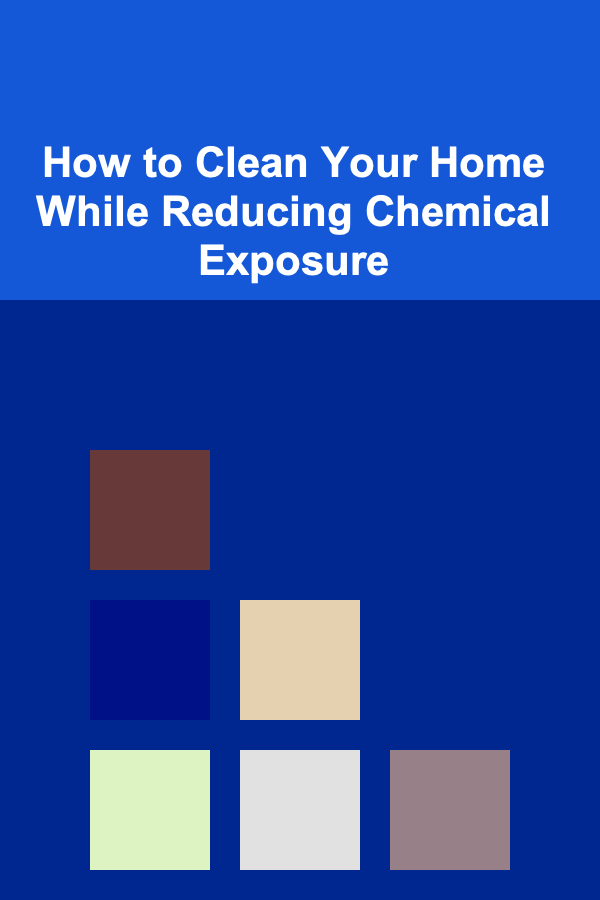
How to Clean Your Home While Reducing Chemical Exposure
ebook include PDF & Audio bundle (Micro Guide)
$12.99$10.99
Limited Time Offer! Order within the next:

Cleaning your home is essential for maintaining a healthy and safe living environment. However, many conventional cleaning products contain harmful chemicals that can negatively affect your health, the environment, and indoor air quality. These chemicals, such as ammonia, chlorine bleach, phthalates, and artificial fragrances, are often linked to respiratory issues, allergies, and other health problems. The good news is that it's possible to clean your home effectively while reducing chemical exposure by opting for natural cleaning solutions, mindful practices, and sustainable habits.
This article delves into practical tips for cleaning your home while minimizing chemical exposure, offering insights on eco-friendly cleaning products, DIY alternatives, and strategies for maintaining a clean space that promotes overall well-being.
Understanding the Risks of Conventional Cleaning Products
Before we explore alternatives, it's crucial to understand why conventional cleaning products are concerning. Most store-bought cleaners contain chemicals that can be harmful when used improperly or in large quantities. Here are some of the common risks associated with chemical cleaners:
1.1 Respiratory Issues
Many cleaning products release volatile organic compounds (VOCs) into the air, which can irritate the respiratory system. These VOCs can trigger asthma, allergies, and other breathing difficulties. For people with pre-existing conditions, the exposure can exacerbate symptoms, leading to long-term health problems.
1.2 Skin Irritation and Allergies
Harsh chemicals like bleach or ammonia can cause skin irritation, redness, and allergic reactions. Prolonged exposure can lead to more serious conditions like eczema or dermatitis, particularly if cleaning is done without gloves or proper ventilation.
1.3 Environmental Impact
Chemicals from conventional cleaners can contaminate waterways and harm aquatic life. Some of these chemicals do not break down easily, and they end up in rivers and oceans, polluting the ecosystem. Additionally, the packaging of many cleaning products contributes to plastic waste and environmental degradation.
1.4 Endocrine Disruption
Certain chemicals found in cleaning products, such as phthalates and parabens, are endocrine disruptors. They can interfere with hormone function, potentially leading to reproductive issues, developmental problems, and other long-term health consequences.
How to Clean Without Chemicals
Switching to non-toxic cleaning practices doesn't mean sacrificing cleanliness. You can maintain a spotless home using natural cleaning agents and simple practices that reduce chemical exposure. Here's how:
2.1 Use Natural Ingredients
One of the best ways to reduce chemical exposure while cleaning is to rely on simple, natural ingredients that are both effective and safe. Here are a few ingredients you can use:
2.1.1 Baking Soda
Baking soda is a powerful natural cleaner that can be used to scrub, deodorize, and even remove stains. It is mildly abrasive, making it perfect for cleaning surfaces like countertops, sinks, and bathtubs without causing damage.
- Deodorizer: Place an open box of baking soda in areas prone to odors, like the refrigerator or trash can, to absorb smells naturally.
- Scrubbing Paste: Create a paste by mixing baking soda with water. Use it to clean stubborn grime, grease, or soap scum.
2.1.2 Vinegar
Vinegar is a versatile natural cleaner known for its disinfectant and deodorizing properties. It can be used to clean glass, countertops, and even as a fabric softener.
- Glass Cleaner: Mix equal parts of vinegar and water in a spray bottle. Spray on glass surfaces and wipe with a microfiber cloth for streak-free results.
- Deodorizer: Use a bowl of vinegar to neutralize bad smells in rooms, closets, or carpets.
2.1.3 Lemon Juice
Lemon juice is another excellent natural cleaner with antibacterial and antiseptic properties. It's especially useful for cutting through grease and leaving a fresh scent.
- Degreaser: Mix lemon juice with vinegar or baking soda to remove grease and stains from kitchen surfaces.
- Polisher: Lemon juice can be used to polish metal fixtures and remove tarnish from brass or copper.
2.1.4 Castile Soap
Castile soap is a plant-based soap that's gentle on the skin and effective for cleaning. It can be used for cleaning floors, countertops, and even for washing dishes.
- All-purpose Cleaner: Dilute castile soap with water to create a non-toxic all-purpose cleaner for most surfaces.
- Dish Soap: Use castile soap as an alternative to conventional dishwashing liquid for a natural and effective solution.
2.1.5 Essential Oils
Essential oils not only add a pleasant fragrance to your cleaning routine, but many also have antibacterial, antiviral, and antifungal properties. Tea tree oil, lavender oil, and eucalyptus oil are particularly effective for cleaning purposes.
- Disinfecting Spray: Mix water, vinegar, and a few drops of tea tree oil to create a natural disinfecting spray.
- Air Freshener: Add a few drops of your favorite essential oil to a diffuser or mix with water in a spray bottle to freshen the air.
2.2 DIY Cleaning Recipes
Creating your own cleaning solutions is simple, cost-effective, and ensures you know exactly what's in the products you're using. Here are some popular DIY recipes:
2.2.1 All-Purpose Cleaner
Ingredients:
- 1 cup distilled white vinegar
- 1 cup water
- 1 tablespoon baking soda
- 10 drops essential oil (e.g., lavender or lemon)
Instructions:
- Mix all ingredients in a spray bottle.
- Shake well to combine.
- Spray onto surfaces like countertops, sinks, and bathroom tiles, then wipe with a cloth or sponge.
2.2.2 Bathroom Cleaner
Ingredients:
- 1/2 cup baking soda
- 1/4 cup liquid castile soap
- 1/4 cup water
- 10 drops tea tree oil (optional)
Instructions:
- Combine baking soda, castile soap, and water in a bowl.
- Stir to form a paste.
- Apply to bathroom surfaces and scrub with a sponge or brush.
2.2.3 Floor Cleaner
Ingredients:
- 1 gallon warm water
- 1/4 cup white vinegar
- 1 tablespoon castile soap
Instructions:
- Mix the ingredients in a bucket.
- Mop floors as usual, making sure to rinse the mop frequently.
- Allow the floor to air dry.
2.3 Eco-Friendly Commercial Products
If DIY cleaning solutions are not your preference, you can find eco-friendly commercial cleaning products that are non-toxic, biodegradable, and free from harsh chemicals. Look for products that have certifications, such as:
- Green Seal Certification: This certification indicates that the product meets strict environmental and health standards.
- EPA Safer Choice: This label ensures that the product is safer for human health and the environment.
Many companies now offer plant-based, biodegradable cleaners that work as well as conventional products without the harmful chemicals. Some popular eco-friendly brands include Method, Seventh Generation, and Mrs. Meyer's Clean Day.
2.4 Clean Smarter, Not Harder
Reducing chemical exposure while cleaning is not just about the products you use but also about how you clean. Here are some strategies to minimize the need for harsh chemicals:
2.4.1 Regular Maintenance
Keeping your home clean with regular maintenance reduces the need for heavy-duty cleaners. Wipe down surfaces after each use, vacuum floors regularly, and clean bathrooms weekly to prevent dirt and grime buildup.
2.4.2 Spot Cleaning
Spot cleaning stains or spills immediately prevents them from becoming stubborn, requiring the use of harsh chemicals to remove them. Keep a cleaning cloth and natural cleaning spray handy for quick clean-ups.
2.4.3 Use Microfiber Cloths
Microfiber cloths are highly effective at trapping dirt, dust, and bacteria, allowing you to clean surfaces without chemicals. They are reusable, making them an eco-friendly option for maintaining a clean home.
2.4.4 Avoid Over-Cleaning
Over-cleaning can lead to unnecessary chemical exposure and waste. Focus on cleaning high-traffic areas and spots where bacteria and dirt are most likely to accumulate. For example, disinfect kitchen counters after food preparation and clean the bathroom after use.
2.5 Reducing Chemical Exposure in the Air
In addition to cleaning surfaces, it's important to reduce airborne chemicals and toxins in your home. Here are a few strategies to improve indoor air quality:
2.5.1 Ventilation
Open windows and use exhaust fans to improve air circulation and reduce indoor air pollution. This helps to clear out VOCs and other chemicals that may be present in your home from cleaning products or building materials.
2.5.2 Houseplants
Certain houseplants, like peace lilies, spider plants, and snake plants, are known for their ability to purify the air by absorbing toxins. Adding plants to your home can help reduce the overall chemical load in your environment.
2.5.3 Non-Toxic Candles and Air Fresheners
Many candles and air fresheners contain chemicals like phthalates, which can contribute to indoor air pollution. Opt for beeswax or soy candles with natural scents, or use essential oils in a diffuser for a non-toxic alternative.
2.6 Waste Reduction and Recycling
In addition to reducing chemical exposure, it's essential to minimize the environmental impact of your cleaning routine by adopting sustainable habits. Recycle cleaning product containers when possible, and opt for bulk refills to reduce plastic waste. Many eco-friendly cleaning products are sold in reusable packaging, helping you reduce single-use plastics.
Conclusion
Cleaning your home while reducing chemical exposure is not only beneficial for your health but also for the environment. By using natural cleaning solutions, embracing DIY recipes, and incorporating eco-friendly products and practices, you can effectively clean your home without relying on harsh chemicals. Simple changes, such as regular cleaning, ventilation, and using non-toxic alternatives, can make a significant difference in creating a healthier living space for you and your family. The key is to take small, conscious steps toward a more sustainable and chemical-free cleaning routine, and the results will benefit both your health and the planet.

How to Create a Profitable Travel Lifestyle: Make Money While You Explore
Read More
How to Set Up Automated Backups to Protect Your Business Data
Read More
Start Here: Learning to Code for Kids
Read More
How to Navigate Glaciers and Ice Fields
Read More
Understanding the Problem of Evil
Read More
Understanding SLAM (Simultaneous Localization and Mapping) in Augmented Reality
Read MoreOther Products

How to Create a Profitable Travel Lifestyle: Make Money While You Explore
Read More
How to Set Up Automated Backups to Protect Your Business Data
Read More
Start Here: Learning to Code for Kids
Read More
How to Navigate Glaciers and Ice Fields
Read More
Understanding the Problem of Evil
Read More